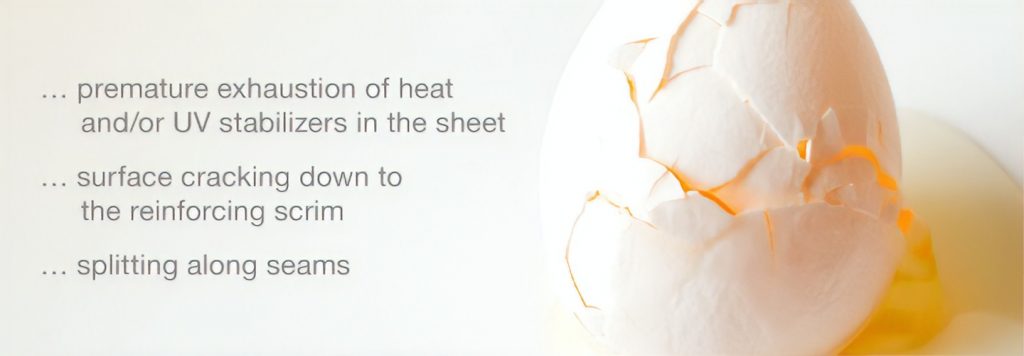
Evaluating the Durability of Thermoplastic Polyolefin (TPO) Roofing Systems
Not all white thermoplastics are created equal. Respected roof consultants and other industry observers are formally voicing their concerns about roof systems made from thermoplastic polyolefin (TPO) and their inability to perform as expected by building owners and specifiers. Issues include premature exhaustion of heat and/or UV stabilizers in the sheet, surface cracking down to the reinforcing scrim, and splitting along seams.
- POOR TRACK RECORD OF PROVIDING LEAK-FREE PROTECTION AND LONGEVITY – Benchmark Roof and Pavement Consultants concluded that persistent issues with TPO’s long-term performance have not been resolved to their satisfaction. As a part of its findings, Benchmark cites an advisory the Midwest Roofing Contractors Association issued through its T&R committee urging members to use caution in specifying TPO, prompted by continuing concern over accelerated weathering from high thermal or solar loading.1
- NOT SUITABLE FOR VEGETATED ROOF SYSTEMS – The NRCA Vegetative Roof Systems Manual, Second Edition, states that TPO membranes should not be used as the waterproofing layer in planted roof systems.2
- ABSENCE OF A STRONG STANDARD – The National Roof Contractors Association commented on the U.S. product standard for TPO membranes, ASTM D6878, that the 2003 standard is one of the least stringent in the roofing industry, and reports that the effort to strengthen it is so far going nowhere.3
Balancing cost with proven performance, independent studies show that thermoplastic PVC roof systems stand the test of time.4 The British Board of Agrément, which provides authoritative and independent information on the performance of building products via its certificate system, found that PVC roofing membranes can last in excess of 30 years, based on site inspections and laboratory tests on new and aged material. Many remain in service far longer than that.
Building owners and specifiers want a tested and trusted roofing material, not one that should have lasted decades but failed in a matter of years. What is your peace of mind worth?
Stay tuned for additional information on other vinyl roofing research, including its performance in spread-of-fire testing and in a multi-year study comparing the relative durability of 12 roofing materials after four years of exposure in three climate zones.
References
Footnotes
1Thermoplastic Polyolefin Membranes (TPOs) – What We Think, ![]() (2.5 MB) by Jeff Evans, RRC, May 2010
(2.5 MB) by Jeff Evans, RRC, May 2010
2NRCA Vegetative Roofs Systems
3TPO Developments or Lack Thereof, ![]() (53 KB) by Mark S. Graham, Professional Roofing, February 2011
(53 KB) by Mark S. Graham, Professional Roofing, February 2011
4Predictive Service Life Tests for Roofing Membranes, ![]() (450 KB) Simpson Gumpertz & Heger Inc., the U.S. Army Corps of Engineers Construction Engineering Research Lab, and the National Research Council of Canada, 2005
(450 KB) Simpson Gumpertz & Heger Inc., the U.S. Army Corps of Engineers Construction Engineering Research Lab, and the National Research Council of Canada, 2005
References & News
Vinyl Durability News
- DURABILITY RESEARCH FINDS VINYL ROOFING RANKS HIGH AMONG COMMON MATERIALS IN AGING COMPARISONS
Download full document [26.1 KB]
[26.1 KB]
- VINYL ROOFING SYSTEMS: QUESTIONS ANSWERED
Read the full article here
- MEETING ROOFING NEEDS – VINYL ADDRESSES A RANGE OF ROOFING REQUIREMENTS
Download full document [580 KB]
[580 KB]

